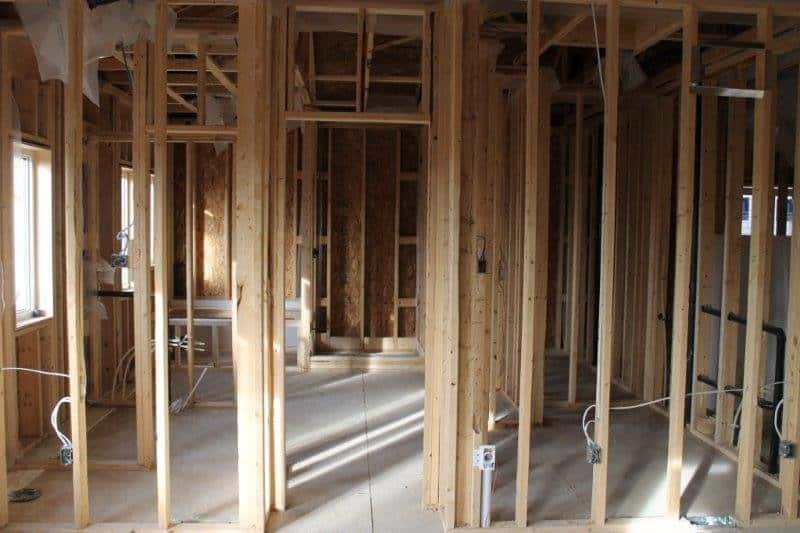In North America, it is common to see houses made of wood and brick, while in Europe, concrete and stone are more prevalent. Concrete homes are solid and unlike wood-framed homes, won’t have floors that creak.
This raises the question: why are houses in America made of wood and brick?
A Brief History
The history of house construction in North America goes back to the first settlers who arrived in the early 1600s. They built homes using whatever materials were available, such as logs, clay, and straw. As settlements grew and expanded, the materials used to construct homes evolved.
During the 1700s, timber frame construction became more popular in North America. This type of construction involved a frame made of large timbers, with smaller pieces of wood used to fill in the gaps. The spaces between the timbers were then filled with mud or clay.
In the mid-1800s, balloon framing became popular. This technique involved using long, straight pieces of lumber to create a frame for the house. Balloon framing allowed for more open floor plans and larger rooms.
Fast forward to present day, the US and Canada are the largest producers of softwood lumber which is typically used for wooden-frame homes. Softwood lumber is wood that comes from trees with needles instead of leaves, such as pine, fir, and spruce. It is commonly used in the construction of houses for framing, roofing, and exterior siding.
The Pros and Cons of a Wooden-Frame Home
Wooden-frame homes have some advantages over other types of construction. They are relatively inexpensive to build and can be constructed quickly. Wood is also a renewable resource, making it an environmentally-friendly choice.
However, wooden-frame homes also have some drawbacks. They are vulnerable to fire, pests, and moisture damage. Proper maintenance is essential to prevent these issues.
Brick homes are durable and long-lasting. They are fire-resistant and offer good insulation. Brick homes also require less maintenance than wooden-frame homes.
However, brick homes are more expensive to build than wooden-frame homes. They are also heavier, which can make them more difficult to transport and install.
And wood-framed homes often have a brick exterior so in essence, it’s a wood-framed home with brick used on the outside, combining the use of both building materials.
Here’s a more detailed list of the pros and cons of wooden-framed homes.
| Pros | Cons |
|---|---|
| Cost-effective: Wood is generally less expensive than other building materials, making it a cost-effective choice for homeowners on a budget. | Vulnerability to pests: Termites and other pests can damage wood-framed homes, potentially leading to costly repairs. |
| Sustainability: Wood is a renewable resource that can be sustainably sourced, making it a more environmentally-friendly choice than some other materials. | Vulnerability to moisture: Wood is also susceptible to moisture damage, which can lead to mold and rot. Proper ventilation and maintenance are essential to prevent this. |
| Ease of construction: Wood is a lightweight material that is relatively easy to transport and work with, making it a popular choice for builders. | Fire risk: Wood is flammable, and wood-framed homes can be more vulnerable to fire than other types of construction. Proper fire safety measures must be taken to mitigate this risk. |
| Design flexibility: Wood can be cut and shaped in a variety of ways, allowing for a wide range of design options for homeowners. | Noise insulation: Wood-framed homes can be less effective at blocking noise from outside than homes made of other materials. |
| Energy efficiency: Wood can be a good insulator, helping to keep homes cool in the summer and warm in the winter. | Durability: While wood can last a long time with proper maintenance, it is generally not as durable as some other materials, such as brick or concrete. |
It’s important to note that not all wood-framed homes will have the same pros and cons – factors such as the quality of the wood and the construction techniques used can make a significant difference in the home’s overall performance.
Final thoughts
The choice of wood and brick for home construction in America is rooted in history and practicality. Wood was readily available and relatively easy to work with, making it a popular choice for early settlers. Today, wooden-frame homes continue to be popular due to their affordability and ease of construction.
However, brick homes also have their advantages, such as durability and fire resistance. Ultimately, the choice between building material depends on the individual needs and preferences of the homeowner.
And since we started the article referring to concrete homes, let’s end on that subject too. There are several reasons why concrete homes aren’t as common in North America as they are Europe and other parts of the world, including:
- Lack of flexibility: Concrete homes are difficult to modify or remodel due to their rigid nature. Any changes to the layout or structure of the home can be challenging and expensive to make. Wooden-framed homes don’t have this problem.
- Environmental impact: The production of concrete is a significant contributor to greenhouse gas emissions, and the mining of raw materials can have negative impacts on the environment. Wood is a renewable resource on the other hand.
- Initial cost: Concrete homes can be more expensive to build than traditional wood-framed homes, primarily due to the higher cost of materials and specialized labor required for construction. However, it’s worth noting that the long-term maintenance costs of a concrete home can be lower than those of a wood-framed home.


